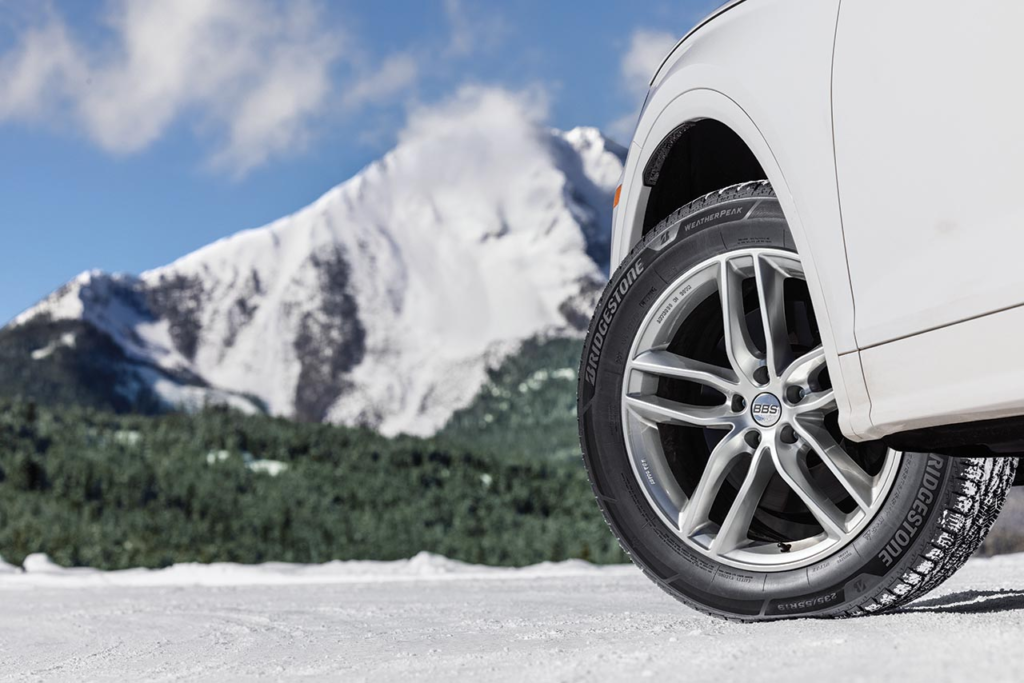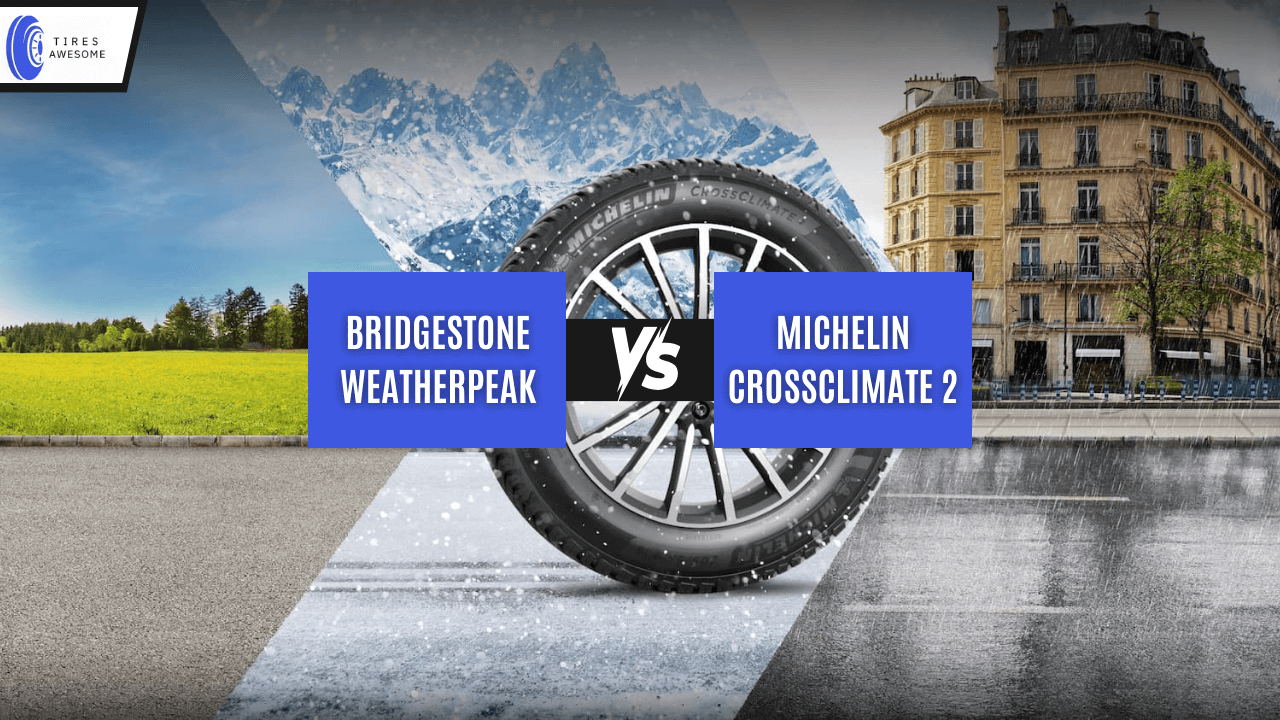Prepare to revolutionize your driving experience with a pair of game-changing all-season tires! We’re pitting two industry giants against each other: Bridgestone Weatherpeak vs Michelin Crossclimate 2.
These innovative rubber marvels will equip you for any road adventure, whether it’s raining, snowing, or extremely hot! Join us as we analyze the differences between these competitors, allowing you to make an educated decision that caters to your driving style and preferences.
Bridgestone WeatherPeak vs Michelin CrossClimate 2: Comparison Overview
Below is a comprehensive analysis of the weatherpeak vs crossclimate 2 tires, showcasing their respective strengths and weaknesses in diverse categories.
| Bridgestone WeatherPeak | Michelin CrossClimate 2 | |
| Dry Performance | Good | Better |
| Wet Performance | Good | Better |
| Snow Performance | Better | Good |
| Noise | Less | More |
| Longevity | Longer | Shorter |
| Fuel Efficiency | Higher | Lower |
| Treadwear Warranty | 70,000 miles | 60,000 miles |
| Price | Cheaper | More Expensive |
Michelin Crossclimate 2 vs Bridgestone Weatherpeak: Detailed Comparison

Dry Performance
There is no significant performance difference between the Bridgestone WeatherPeak and the Michelin CrossClimate 2 on dry surfaces.
The Michelin CrossClimate 2 outshines its counterpart regarding dry braking and handling capabilities. This is mainly due to the bevelled tread block edges on the CrossClimate 2, allowing shorter stopping distances on dry pavement. The CrossClimate 2 exhibits higher handling performance when driving on paved roads.
The Bridgestone WeatherPeak performs well on dry surfaces, it possesses less noteworthy features than its competitor. It needs to catch up regarding dry braking and handling abilities compared to the CrossClimate 2. If optimal dry performance is a priority for drivers, they might find that the Michelin CrossClimate 2 offers a more satisfying experience.
Wet Performance
The Michelin CrossClimate 2 outshines its rival in terms of wet surface performance due to its innovative features. One notable aspect is the improved handling it provides on wet roads.
When it comes to rainy conditions, the Michelin CrossClimate 2 slightly falls short in terms of confidence compared to its competitor.
One reason for this is that the CrossClimate 2 utilizes Michelin’s EverGrip Technologies, which are specifically designed to enhance traction and control on wet surfaces. These technologies include special compounds in the tire’s tread that allow it to maintain better grip even in slippery conditions.
The Michelin CrossClimate 2 incorporates V-shaped grooves strategically placed within the tread pattern. These grooves effectively evacuate water from the center of the tread towards the shoulders, aiding in hydroplaning resistance and further improving performance on wet surfaces.
Snow Performance
The Weatherpeak Tires have shown a shorter snow braking distance and enhanced stopping power on slippery surfaces compared to other models. These tires boast a higher number of sipes, which are small slits in the tread blocks that allow for better traction in light snow and slushy environments.

The Michelin CrossClimate 2 excels in its snow handling capabilities while also performing satisfactorily on icy roads. When comparing both options, the CrossClimate 2 seems to hold an advantage over the Weatherpeak tires due to its balanced performance across various winter scenarios.
Road Noise
The Michelin CrossClimate 2 Tires tend to produce more noise. This aspect becomes particularly noticeable as the CrossClimate 2 tires age, especially after reaching a mileage of 60,000 miles; despite the increasing noise levels, the overall performance of the CrossClimate 2 tires remains highly commendable.
If minimizing road noise is a priority for you, then the Bridgestone WeatherPeak tires are recommended. These tires are designed with reduced noise in mind and provide a quieter driving experience compared to their Michelin counterpart.
While the noise level of the CrossClimate 2 tires may rise over time, it is essential to note that their performance still holds up admirably. They excel in other vital factors, such as traction, handling on dry and wet surfaces, and braking capabilities.
Longevity & Fuel Efficiency
The Bridgestone WeatherPeak tire boasts an impressive UTQG treadwear rating of 700, outperforming the Michelin CrossClimate 2 with its rating of 640. It indicates that the Bridgestone tire has the potential to last longer before requiring replacement.
While the Michelin tire tends to experience faster tread wear due to its higher rolling resistance.

In practical terms, while both tires offer good traction and performance in various weather conditions, the Michelin tire may have a shorter lifespan than the Bridgestone option. Due to its higher rolling resistance, the Michelin tire can decrease fuel efficiency by around 5 to 10 mpg compared to the Bridgestone tire.
Cost
The pricing for the Bridgestone WeatherPeak starts at $166, making it a highly cost-effective option for those on a budget. This tire is available in numerous sizes, providing consumers with a wide range of choices to fit their specific vehicle requirements.
The Michelin CrossClimate 2 boasts a wider price range, stretching from $170 all the way up to $382. This indicates that while there may be more expensive options within the Michelin lineup, there are also more affordable variations depending on one’s preferred tire size.
Warranty
The Bridgestone WeatherPeak takes the lead with its impressive 70,000-mile Limited Warranty. It means you can rely on these tires for an extended period before needing a replacement.
While the Michelin CrossClimate 2 offers a slightly shorter tread life warranty with its 60,000-mile Manufacturer’s Treadwear Limited Warranty.
With Bridgestone’s WeatherPeak, you can rest assured that these tires are built to last and withstand various weather conditions. Regardless you encounter rain, snow, or dry pavement, these tires are designed to provide exceptional traction and grip. The more extended tread life warranty is a testament to the durability and longevity of these tires.
The Michelin CrossClimate 2 also offers reliable performance in different weather conditions. Although it falls slightly short in tread life compared to the Bridgestone WeatherPeak.
Conclusion
When choosing Bridgestone Weatherpeak vs Michelin Crossclimate 2, your choice might be influenced by the type of performance you value the most. If dry performance is a top priority for you, then the Michelin CrossClimate 2 could be the better option.
These tires provide exceptional grip and stability on dry surfaces, offering an optimal driving experience. If you frequently drive in wet weather conditions or encounter heavy rainfall, the Michelin CrossClimate 2 tires also outshine their counterparts.
FAQs
Is Michelin CrossClimate2 Worth it?
Yes,One key feature that sets the CrossClimate2 apart is its all-weather performance capability. The tire is designed to ensure optimal grip in both wet and dry conditions, offering enhanced safety and confidence on various road surfaces.
What is the Top Speed of the CrossClimate 2?
With its advanced technology and innovative design, the CrossClimate 2 can comfortably handle speeds up to 168 mph (270 km/h) while ensuring excellent grip and control on various road surfaces.
Are Michelin CrossClimate 2 Good in the Rain?
When it comes to rain, these tires truly shine. The CrossClimate 2 is engineered with an innovative compound and tread design that allows it to deliver excellent traction on wet surfaces, providing drivers with confidence and control even in heavy rain.
Which One is Better Michelin or Bridgestone?
If you frequently drive in challenging weather conditions such as wet roads, heavy rain, or snow, it’s advisable to opt for Michelin tires over Bridgestone. For regular road conditions, both Bridgestone and Michelin are viable options.

